
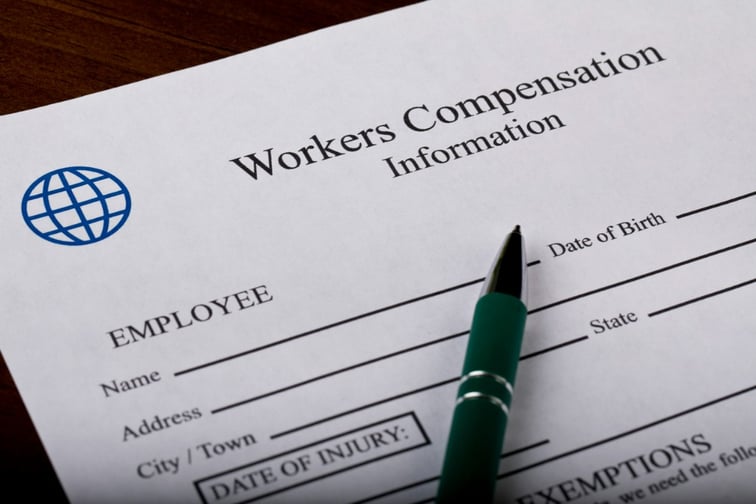
Getting sick or injured while doing your job qualifies you for workers’ compensation, which covers your treatment expenses, as well as a portion of lost income. However, because of the myriad of factors involved, determining the exact cost of coverage can be a tricky endeavor.
This is the reason why workers’ compensation settlement charts have been created. A workers comp settlement chart helps provide an accurate estimate of how much compensation an injured worker should receive. But each state uses its own set of settlement charts, which adds another level of complexity.
In this article, Insurance Business will discuss everything you need to know about workers comp settlement charts. We will explain how this tool works, provide a state-by-state comparison, and show you how workers’ compensation costs are calculated. This piece can serve as a handy guide for employees and companies trying to work out how much workplace injuries can cost them, so we also encourage insurance professionals to share it with their business clients. Read on and find out how a workers comp settlement chart can help with a claim. For our usual insurance professional readers, this article serves as a good primer for potential clients to understand the need for this type of insurance, and to understand it in their jurisdiction. Feel free to forward this along to them!
In general, a workers comp settlement chart details how much compensation to expect if you have been injured as a direct result of your job. But because different states have different rules when it comes to workers compensation, they also use varying settlement charts.
Most states have settlement charts that list the cost of compensation for the loss or impairment of different body parts. These often include specific timeframes, usually in weeks, assigned to each body part, and corresponding impairment ratings that indicate the severity of the illness or injury.
Doctors typically determine the impairment ratings by looking at how the injury impacts the following aspects of daily life:
To calculate the amount of compensation you should receive, you need to multiply the impairment ratings by the number of weeks you will be needing compensation, then multiply the result by a certain portion of your income.
Here’s an example of an impairment rating workers comp settlement chart, which shows the impairment percentage range for different injuries, with a 100% rating indicating a complete loss.
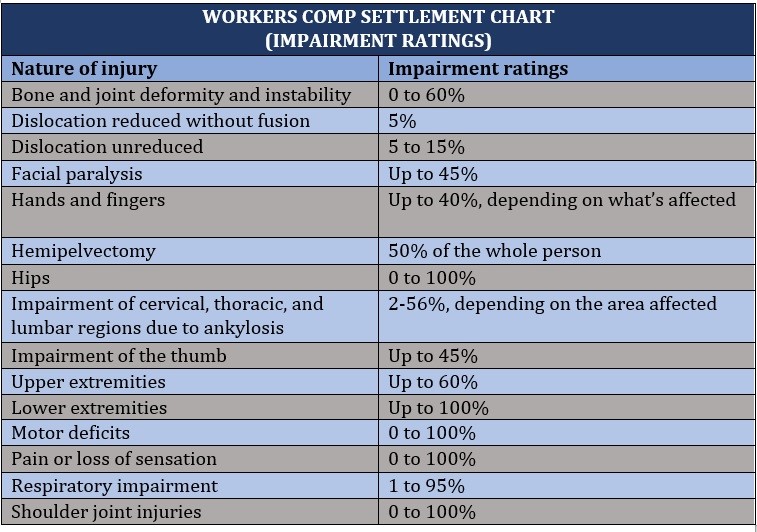
Here’s another workers comp settlement chart, which shows the maximum number of weeks you should receive compensation for a complete impairment or loss.
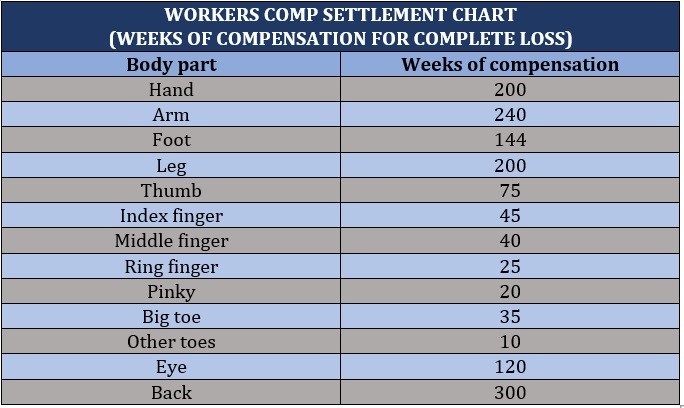
Some settlement charts also show the average amount of payout you can receive for different injuries and impairments. For the table below, we also included examples for clarity, although these are not always included.
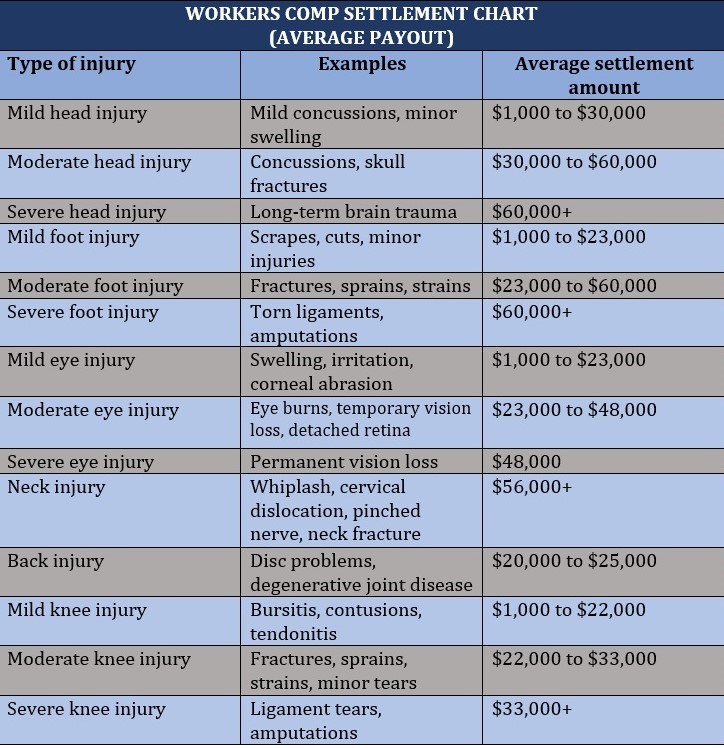
Each state implements different laws and regulations on workers’ compensation, which is also why each state uses different sets of workers comp settlement charts. You can click on the links in the table below to find out what charts your state uses and how it calculates workers’ compensation payouts.
|
STATE-BY-STATE COMPARISON OF WORKERS’ COMPENSATION BENEFIT RATES |
|||
|---|---|---|---|
The combined average cost for workplace illness and injury claims is $41,353, according to the most recent data available from the National Council on Compensation Insurance (NCCI). To get a clearer picture of the average compensation workers receive for different job-related injuries and illnesses, the council calculated medical and indemnity costs based on these three major categories:
The tables below serve as a form of workers comp settlement chart, detailing which job-related injuries offer the highest average payouts.
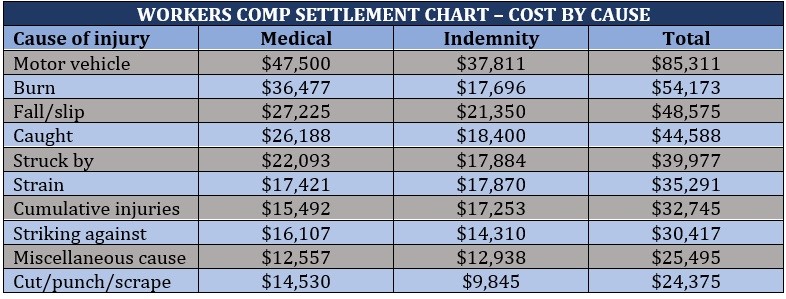
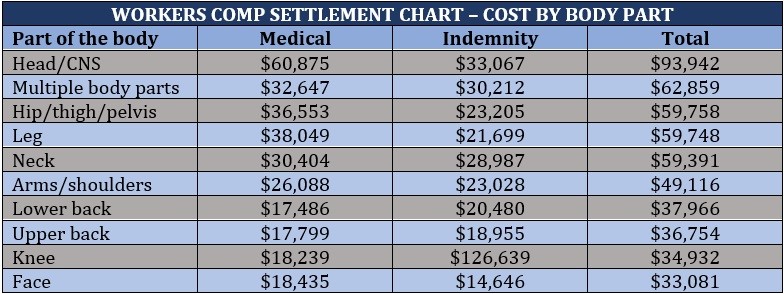

Workers’ compensation insurance, however, is just one of the several coverages that can provide you with financial protection if an injury prevents you from earning a living. Disability insurance also pays out a portion of your income if you are unable to perform your job because of an unexpected illness or injury.
The amount of compensation you will receive for a workplace illness or injury depends on a range of factors, including:
You can choose to receive payouts either as a lump sum or as structured weekly or bi-weekly payments. The drawback of choosing one-time payouts is that you are also essentially waiving your right to reopen your claims in the future. This means if you’re illness or injury worsens, you will be solely responsible for shouldering your medical expenses. Opting for structured payments is ideal if you are not sure how your injury will affect your life in the future.
Workers’ compensation plans offer a range of coverages that can soften the financial blow of a work-related injury. These include:
Although workers’ compensation insurance offers a broad range of coverage, there are times when your claim can be rejected. If you want to find out the common reasons why a workers comp claim is denied and how you can avoid them, just click on the link to access our guide.
In its latest report, the National Academy of Social Insurance (NASI) revealed how much workers comp coverage costs in each state. These are the top 10 states with the highest workers compensation rates:
Meanwhile, these are the 10 states with the lowest workers comp rates:
If you’re wondering why the rates are so low, it is because workers’ compensation rates are expressed as a dollar amount that a business pays in workers comp coverage per $100 in payroll. Also called premium index rate, these figures are used in calculating the cost of workers’ compensation coverage. The formula is annual payroll divided by 100, then multiplied by your state’s workers comp rate.
For example, a small business based in Wyoming, where the rate is $1.78, with a yearly payroll of $200,000 is expected to pay around $3,560 in annual premiums. The amount, of course, can go higher or lower, depending on a range of other factors, including the industry the company is in and past claims.
If you’re looking for top-of-the-class insurance companies in the US that offer the best workers’ compensation coverages, then our Best in Insurance Special Reports page is the place to go. Here, you can find insurers that have been handpicked and nominated by their peers and recognized by our panel of industry experts as trusted and reliable market leaders.

Recently, we unveiled our five-star awardees for this year’s Top Workers’ Compensation Insurance Companies. For months, the Insurance Business research team conducted one-on-one interviews and polled hundreds of workers comp specialists to get their take on the most important attributes they consider when searching for the right workers compensation coverage for their clients. You can check out the complete survey results, along with the complete roster of this year’s awardees by clicking the link above.
Do you think a workers comp settlement chart is effective in helping workers get the compensation that they deserve? Feel free to share your thoughts in the comments section below.
